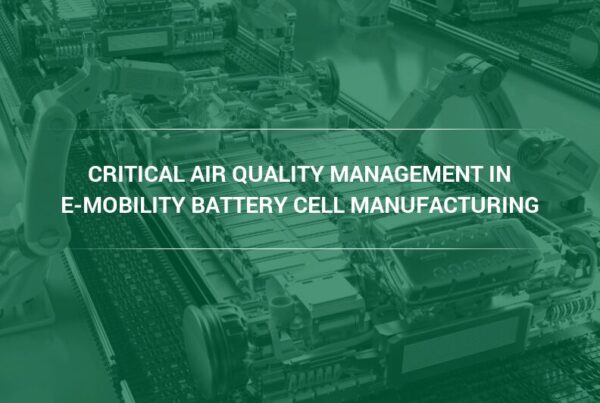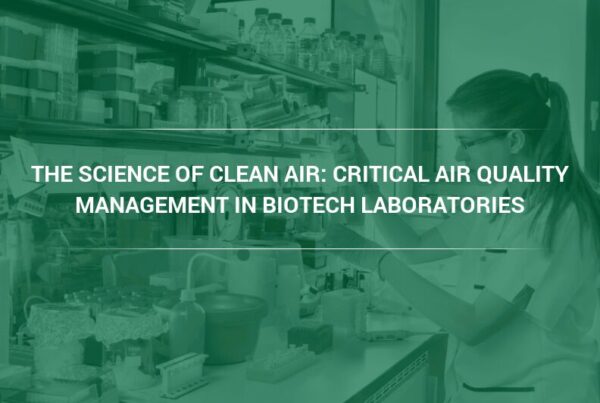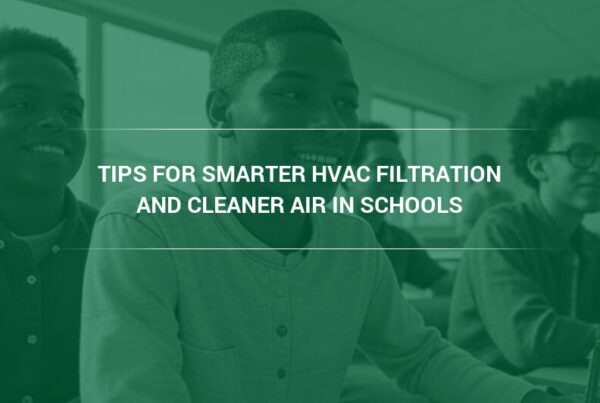Indoor air quality in schools is often overlooked, yet it plays a critical role in student health, cognitive performance, and overall well-being. By addressing air quality proactively, schools can create safer and healthier spaces that enhance learning outcomes.
This article explores why clean air is vital for academic success, the air quality challenges schools face, and how filtration systems can mitigate these issues. Additionally, Camfil’s team of air quality specialists provides practical insights into choosing the right air filtration systems and strategies for schools to maximize their indoor air quality.
Air Quality Challenges in Schools
Schools are unique environments in terms of air quality, but share many of the same challenges as other commercial and public buildings.
Common Pollutants Found in Schools
Schools can harbor a variety of airborne pollutants, such as:
- Particulate Matter (PM): Dust, dirt, and small particles that come from both indoor and outdoor sources.
- Airborne Allergens: Pollen, pet dander, and dust mites can trigger allergies and asthma symptoms in students and staff.
- Biological Contaminants: Biological contaminants are microorganisms like bacteria and viruses that can pose the risk of illness outbreak when present in the air.
- Mold: Often allowed to grow by poor ventilation or water damage, breathing in mold can cause a range of health issues, ranging from mild respiratory irritation to neurological and organ damage depending on the species of mold.
- Volatile Organic Compounds (VOCs): Chemicals found in cleaning supplies, art materials, and building materials that can cause headaches, nausea, and other health issues.
Health Risks of Poor Air Quality
Exposure to these pollutants has significant health implications, particularly for elementary and middle school children, due to their lung capacity being larger relative to their body size than that of adults and because their respiratory systems are still developing. Poor air quality has been linked to:
- Increased incidences of asthma and allergies
- Cognitive impairments such as difficulty concentrating
- Long-term risks like respiratory illnesses
In regard to the health effects of specific types of pollution, PM can irritate the respiratory system and exacerbate existing conditions like asthma. Allergens can trigger allergic reactions or even cause new allergies to develop over time with frequent exposure. Volatile Organic Compounds (VOCs) can pose serious health risks, including respiratory irritation, headaches, and long-term exposure may lead to liver, kidney, or central nervous system damage.
Added Challenges in Colleges and Universities
Although there are plenty of challenges related to indoor air quality in elementary, middle, and high schools, higher education institutions have additional concerns to address:
Higher education institutions face unique challenges when it comes to indoor air quality. Shared living spaces, like dormitories, increase the need to eliminate mold spores, bacteria, and viruses. Additionally, both the age of college students and the fact that many of them live on campus means that the risk of on-campus substance use is higher than in high schools, making it crucial to protect students from secondhand smoke from tobacco and marijuana.
Large public universities face even greater challenges due to high population density and large lecture halls, which create ideal conditions for the spread of airborne illnesses. Unlike K-12 schools, where vehicle pollution is concentrated at drop-off and pick-up times, universities experience constant traffic throughout the day due to varied class schedules.
Research institutions add another layer of complexity, with campus spaces generating potentially dangerous air pollutants depending on the type of research conducted. Some labs also require cleanroom conditions to ensure the integrity of their work. Addressing these factors is essential to maintaining safe and healthy environments on college campuses.
READ MORE: Strategies to Improve Indoor Air Quality Throughout the University Campus
The Benefits of Air Filtration Systems in Schools
Implementing high-quality air filtration systems offers tangible benefits that extend beyond just reduced physical health risk.
1. Improved Academic Performance
Better air quality significantly enhances students’ cognitive function, which is essential for learning and performing complex tasks. High levels of indoor air pollution and poor ventilation negatively affect all nine cognitive function domains, including focus, task orientation, and problem-solving abilities. Research shows that improving air quality and ventilation can lead to a 101% increase in cognitive test scores (i.e. scores double), highlighting its critical role in academic success.
Clean air not only supports learning but also boosts productivity. Studies have found that poor indoor air quality can reduce productivity by up to 10%. By removing pollutants and improving ventilation, schools can create healthier environments that optimize both student learning and overall performance.
2. Reduced Absenteeism
By cutting down airborne pollutants such as allergens and viruses, air filtration can lower the chances of illness spreading. This translates directly to fewer sick days for students and staff alike.
READ MORE: Is Air Quality Affecting Absences at Your School?
3. Enhanced Mental Well-Being
Clean indoor air can contribute to a more positive learning and working environment, as high pollution levels are linked to worsening mood and decreased ability to accurately discern the emotions of others.
READ MORE: Air Quality May Impact Aspects of Emotional Intelligence, According to New Study
Finding the Right Filters: Standalone Units vs Integrated Air Filtration Systems
Two main ways of approaching air filtration in commercial and public buildings are integrated air filtration systems and standalone units. Regardless of what approach is chosen, building coordinators should also be aware of the difference between molecular and particulate pollution and the approaches required for each.
To effectively combat the dual threats of gaseous and particulate pollutants, it’s crucial to understand that each requires a distinct type of filter. For particulate pollutants, which include dust, pollen, mold spores, and other solid or liquid particles, mechanical filters (such as HEPA and MERV-rated filters) should be implemented.
To target molecular (or gaseous) pollutants (such as VOCs, odors, and smoke), which are made up of molecules too small to be captured by even the most efficient mechanical filters, activated carbon filters are more suitable. Activated carbon works through a process called adsorption, where gas molecules stick to the surface of the carbon particles. This method is highly effective for reducing harmful gases and improving indoor air quality.
Integrated Systems
Integrated air filtration systems are permanent solutions that work within a building’s HVAC system to filter out pollutants. They offer the benefit of whole-building coverage but also require more upfront investment and a more involved installation process. Key considerations for integrated systems include:
- Choosing the right type of filtration media based on specific pollutants present.
- Ensuring proper maintenance and replacement of filters to maintain effectiveness.
- Coordinating installation with existing HVAC systems.
Standalone Units: Air Cleaners and Air Purifiers
Standalone units offer notable advantages over HVAC filters, particularly in their flexibility and targeted filtration capabilities. Unlike HVAC systems, which are designed to filter air across an entire building, standalone units can be placed in specific areas requiring enhanced air quality, such as classrooms, offices, or medical spaces. They are typically easier to install and maintain as they operate independently of a building’s central system. Additionally, standalone units often provide advanced filtration technologies, like HEPA filters, which can capture smaller particles and allergens more effectively than the panel filters that most HVAC units have the capacity to house. This makes them an ideal choice for addressing localized air quality concerns quickly and efficiently.
Standalone air purifiers, like the CamCleaner CC500, are portable solutions perfect for temporary spaces, classrooms without integrated HVAC systems, or when flexibility is paramount. Key considerations for standalone units include:
- Determine if both particulate and molecular pollution are addressed.
- Confirm the use of real, individually factory-tested HEPA filters to ensure effectiveness.
- Identify their maintenance requirements, such as replacing filters as needed.
A Mid-Atlantic school system faced significant challenges related to indoor air quality (IAQ), particularly in aging facilities without modern HVAC systems. To address these concerns, the district worked with Camfil to implement standalone air purifiers equipped with medical-grade HEPA filters across multiple classrooms. The initiative resulted in measurable improvements in air quality, producing a 98% reduction in particulate matter. The case study highlights the importance of implementing cost-effective, portable air purification solutions in educational settings to create healthier, more productive learning environments.
Combining Integrated Systems with Standalone Units
Combining integrated HVAC filtration systems with standalone air purifiers offers an effective strategy for addressing air quality challenges in areas with higher pollution levels or a greater need for clean air. Integrated systems work as a baseline solution, continuously filtering air across an entire building, while standalone units can be strategically placed in specific high-need locations, such as near entrances, high-traffic zones, or areas with vulnerable populations, by delivering more air changes per hour and filtering smaller particles out of the air. This dual approach ensures comprehensive coverage and provides an extra layer of protection against airborne pollutants.
Implementing Air Filters in Schools
Improving air quality in schools is essential for creating a safe and healthy learning environment for students and staff. One effective way to achieve this is by implementing high-quality air filters. These filters work to remove pollutants, allergens, and harmful particles from the air, ensuring a cleaner and more breathable atmosphere. With concerns about airborne illnesses and environmental contaminants, investing in air filtration systems has become a priority for many schools.
1. Assessing IAQ Needs
The first step in implementing air filters is assessing the specific needs of the school. This involves evaluating the current ventilation systems, identifying areas with poor air circulation, and understanding the unique challenges of the building. Schools in urban areas, for instance, may need filters designed to handle higher levels of outdoor pollutants, while older buildings might require upgrades to accommodate modern filtration systems.
2. Determining Placement Strategies
Once the needs are identified, schools can determine the most effective placement strategies for air filters. Filters should be installed in high-traffic areas such as classrooms, cafeterias, and hallways to maximize their impact. Depending on the products chosen, this step may be limited by the configuration of the building’s HVAC system.
3. Integrating Best Practices for Air Quality Management
Recommended best practices include combining effective filtration systems with proper ventilation to ensure that clean, fresh air circulates throughout the building. Educating staff and students about the importance of air quality helps everyone understand how their actions can make a difference. Additionally, addressing sources of indoor air pollution—such as cleaning chemicals, allergens, and outdated equipment—further enhances the overall air quality, ensuring a healthier space for learning and growth.
4. Stick to the Correct Maintenance Schedule
Maintaining and replacing high-performance air filters on the correct schedule is crucial to ensure they are functioning effectively and providing proper protection for students and staff. Lower quality air filters can become clogged more quickly with dust, allergens, and other airborne particles, reducing their efficiency and potentially allowing harmful pollutants to circulate in the air.
When filters are clogged, it not only leads to less filtered air being delivered into the intended space but also increased resistance, which increases energy consumption as the HVAC equipment must work harder to circulate air through the obstructed filters.
By adhering to a maintenance schedule based on the performance of the filter and not on a routine based on the number of months a filter has been inservice, you can improve indoor air quality, reduce the risk of respiratory issues, create a healthier environment for everyone in the building, while lowering the operational cost of the HVAC systems.
5. Monitoring IAQ to Determine Effectiveness
Continually monitoring pollution levels within school environments is essential for maintaining optimal air quality. This ongoing assessment allows schools to adapt their air quality management strategies in real time, ensuring the health and safety of students and staff. Utilizing advanced sensors and air quality monitoring systems can provide precise data on various pollutants, such as volatile organic compounds (VOCs), particulate matter, and carbon dioxide levels. By analyzing this data, schools can identify trends, detect emerging issues before they become significant problems, and adjust ventilation rates or filtration effectiveness accordingly. Such proactive measures not only safeguard health but also contribute to creating a conducive learning atmosphere by minimizing potential distractions caused by poor air quality conditions.
Initial Investment vs. Total Cost of Ownership: The Value of Camfil Systems
When evaluating the cost of an air filtration system, it’s important to move beyond the initial investment and consider the total cost of ownership. While the upfront cost of a premium air filter may sometimes be higher, its superior energy efficiency and long-term durability result in significant savings over time. By reducing energy consumption and extending filter life, Camfil systems help lower operational expenses, providing an excellent return on investment (ROI).
Camfil systems are engineered for optimal energy efficiency, which directly translates to reduced utility bills. These systems use cutting-edge technology to minimize pressure drop, ensuring your HVAC systems work more effectively without overexerting energy. Over the lifespan of the system, these energy savings can offset the initial investment, making them a smart, sustainable choice for businesses looking to cut costs while maintaining superior air quality.
To consult with an air quality professional about the IAQ needs of your school, get in touch with your local Camfil team.
About Camfil
For over 50 years, Camfil has been developing clean air solutions that enhance well-being, improve productivity, and minimize environmental impact. As a global manufacturer of commercial and industrial air filtration systems, Camfil is committed to conserving resources while benefiting both businesses and the planet. Headquartered in Stockholm, Sweden, Camfil operates 30 manufacturing sites, six R&D centers, and has a presence in over 35 countries with 5,600 employees worldwide. Learn more about creating cleaner, healthier indoor air at www.camfil.us.
Media Contact
Lynne Laake
Camfil USA Air Filters
Phone: 888-599-6620
Email: Lynne.Laake@camfil.com



